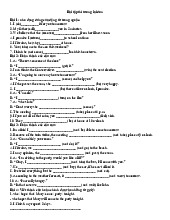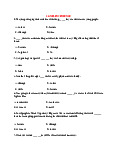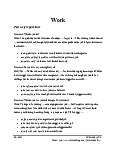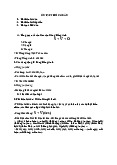





Preview text:
THE STYLISTICS OF ADVERTISING Anamaria Mirabela POP University of Oradea mipop@uoradea.ro Monica Ariana SIM University of Oradea msim@uoradea.ro
Keywords: advertising, stylistics, rhetorical devices, morphology, syntax
With the development of the technology and the massive diversity of the mass media, advertising influences
the daily life of every person. Whatever the forms advertising takes, language is the main carrier of the
message. Advertising language is very different from common language. It is a style of immediate impact and
quick persuasion. It has its own features in morphology, syntax, and rhetorical devices. For a rhetorical
device appeals to the imagination and makes the speech or writing interesting and appealing, advertisers
often use various rhetorical devices to persuade the readers to buy different products. Contents: 1. Introduction 2. Advertising Language 2.1 Morphology in Advertising 2.2 Syntax in Advertising
2.3 Rhetorical Devices Used in Advertising 3. Advertising Headlines
3.1 Headline. Definition and Concept
3.1.2 Stylistic Features of Headlines 4. Conclusions 1. Introduction
A rhetorical figure is defined as an artful arrangement of words or meanings designed
to produce a specific effect on an audience (e.g., metaphor, alliteration). Aristotle defined
rhetoric as “the faculty of discovering all the available means of persuasion in any given
situation”. [Corbett, 1990:3] This definition suggests the idea that there is a set of formal
devices capable of achieving certain effects, and that in any given situation some of these
devices will be applicable and others not. Therefore, rhetoric tries to understand what
works in the area of persuasive communication.
Rhetorical figures are very common in the headlines of contemporary magazine and
newspaper advertising throughout the world. It means that these figures can be found
across a variety of audiences, magazines, newspapers, product categories, and message strategies.
Cortland L. Bouvee defines advertising as “the non-personal communication of
information usually paid for and usually persuasive in nature about products, services or
ideas by identified sponsors through the various media.”[ Bovee & Arens 1992:7] Nowadays,
with the development of the technology and of the mass media, advertising has influenced
people pervasively in their daily life. However, whatever the promotional strategies
advertising takes, language is the main carrier of message all along, as The Language of
Advertising, by Vestergaard & Schroder, says, “Advertising takes many forms, but in most
of them language is of crucial importance.”[Vestergaard, Schroder, 1985:140] Advertising
language is a style of immediate impact and rapid persuasion. The use of English in
advertising is a global phenomenon. As Ingrid Piller points out,“English is the most
frequently used language in advertising messages in non-Englishspeaking countries
(besides the local language)”.[ Piller, 2003:175]
American Marketing Manager’s Handbook points out that an advertisement should
have four functions: AIDA, which represent four words - Attention, Interest, Desire, Action.
1. Attention - a good advertisement should attract the consumer to direct their attention to the product of it.
2. Interest - the introduction and publicity of an advertisement should arouse consumers’ great interest.
3. Desire - the publicity of advertising should stimulate consumers’ desire to buy the
product, and make them realize that this product is just what they want.
4. Action - the advertising makes consumer to response to the advertising information and
evoke them to take the action of purchasing. 2. Advertising Language
The wide use of advertising has created a special style of English – advertising English
whose unique characteristics, simple language and important attraction makes it different
from other kinds of languages.
In order to send information, advertising English must be vivid, usual, emotional, and
attractive. In what follows, we will analyze some features of advertising and the way in
which morphology, syntax and rhetorical devices are used in English advertisements in
order to convey the message to the buyer. 2.1.
Morphology in Advertising
The function of advertising is to provide information, attract consumer, and promise
quality. Therefore, advertisement must contain impelling language, and for this it must use
use popular and oral language, easy to understand and memorize.
1. Simple and formal language
For example:“I couldn’t believe it, until I tried it!”, “I’m impressed! I’m really impressed!”, “I
love it!”, “You’ve gotta try it!”. The former is an advertisement of a microwave oven. The
words in it are very simple and oral. It uses the slang “gotta”, which means “got to” in
American English, to give an impression that this advertisement comes from the real life.
2. Misspelling and Coinage - In some of advertisements, there are some words
misspelled on purpose, or some suffixes or prefixes added to the common words. Although
the new words still keep the original meanings, they are quite different from the original
words in spelling, which will make the advertisement more interesting and attractive.
e.g. First of all, because now Yoplait is thicker. Second of all, because it’s creamier. Third
of all, because it’s still 100% natural and really very good for you. Fourth of all, because to
me Yoplait tastes better than all the other Yoyurts. And fifth of all, because…well, just because …”
In addition, some prefixes or suffixes like “super-”, “ex-”, “-er”, “-est” …etc, are often used
to stress the high quality of the product.
3. Loanwords - The most frequently used loanwords are French and Spanish.
e.g. Perrier…with added je ne sais quoi.
The meaning of je ne sais quoi is “I don’t know what”. The purpose to use this simple
French is to show the French flavor of this drink. The loanwords in some advertisement
are good methods to express the exoticism of the products.
e.g. Experience Fiesta through the eyes of real people.
The meaning of the word Fiesta is “party”.
4. Use of verbs - The most frequently used verbs and phrasal verbs are: try, ask, get,
take, let, send ,
for use, call, make, come on, hurry, see, give, come, remember, discover,
serve, introduce, choose, and look for. It has been noticed that these verbs are particularly
used in beauty industry advertisements.
e.g. Our eye shadows, liners, brow products and mascaras will get you gorgeous in a glance.
e.g. Moisture Wear Make-up. It gives life to the look and feel of your skin. Moisturewear
Blush. It brings radiance to the look of your skin.
Good look and young skin are always the things that a women pursue. The use of the verb
give will make this product end up with big sale. Similarly, the word bring is also very
appropriate. Radiance of skin is the thing that almost every woman wants and needs.
5. Use of Adjectives - The purpose of advertising is to publicize products, therefore it
is necessary to describe many aspects of the product such as size, color, nature, and
quality. During this process, adjective plays a vital role.The most frequently used
adjectives are: new, crisp, ,
good/better/best fine, free, big, fresh, great, delicious, real, full,
sure, pure, easy, bright, clean extra ,
, safe, special, rich e.g. Light.Crisp .Refreshing.
e.g. It releases a fresh layer of microlight makeup for each application, allowing you to
achieve a look of pure perfection that’s skin brightening, non-drying, and comfortable to wear every time.
2.2. Syntax in Advertising
1. Simple sentences- It will get better effect to use simple sentences than compound
sentences, because the readers will lose interest in reading complex sentences.
e.g. Maybe she’s born with it. Maybe it’s Maybelline.
2. Interrogative sentences and imperative sentences - Interrogative sentences are
quick and effective to get the readers’ response.
e.g. Do you want the good news or the good news? First the good news: use head &
shoulders regularly and you can have 100% flake free hair. And the good news? Well,
head & shoulders is also a great way to achieve beautiful-looking hair that feels soft, silky and manageable.
The imperative sentences have a meaning of claiming, calling and commanding,
similarly the goal of advertising is to persuade consumers to buy a product or service.
e.g. Run with us! or Just do it!
e.g. Join us in sharing the simple pleasures in life that motivate and inspire you.
3. Minor Clause - Minor clause contains simple elements emphasizing the key words.
It could not only reduce the length and cost, but also disseminate information more effectively.
e.g. Goodyear. We discover, you explore.
2.3. Rhetorical Devices Used in English Advertising
Rhetorical devices are used to make the thought more striking and effective. A fresh
rhetorical device appeals to the imagination, creates mental pictures and makes the
speech or writing impressive and interesting.Due to this, advertisers often use various
rhetorical devices to increase the readability and appeal of an advertisement and to get
consumers’ interest of buying the product.
1. Personification - Personification is a figure of speech in which a thing or abstraction
is represented as a person .The use of personification in advertising will endow the
product with human emotion, and will make them amicable to consumers.
e.g. Kleenex says bless you.
e.g. Cottonelle. Looking out for the family.
2. Simile and Metaphor - Simile is a figure of speech comparing two unlike things,
often introduced with the words “like”, “as”, or “than”.[1]
e.g. Lightweight, extra caring formula for dry and damaged hair. Power hold and a soft touch like Cashmere.
Metaphor is a figure of speech in which a word or phrase literally denoting one kind of
object or idea is used in place of another to suggest a similarity or analogy between them.
[2] Metaphors can be used visually in the picture or verbally in the headline and/or copy.
Since the nature of metaphors involves expressing and experiencing one thing in terms of
another unexpected object, consumers exposed to a metaphoric headline or picture in an
ad will search and tap into their existing knowledge and perceptions of the conventions
and context of the metaphor so as to comprehend the message. e.g. Go for the Gold
The brightest star in electronics.
3. Pun - Pun is a play on words, or the usually humorous use of a word in such a way
as to suggest two or more of its meanings or the meaning of another word similar in sound
e.g. American Home has an edifice complex.
e.g. The more we progress, the better you advance. 4. Repetition
In some advertisements, repetition is used to stress certain information.
e.g. Designed to test limits, designed to be noticed – Bulova
5. Rhyming- One of the best techniques for bringing in the brand name is to make the
slogan rhyme with it. An ad slogan is better if it reflects the brand’s personality. By this kind
of rhyming, the brand name is highlighted.
e.g.The flavour of a Quaver is never known to waver.
e.g.It’s the Viakal fizz that does the bizz!
6. Alliteration - Alliteration can help the slogans achieve the strong beating rhythm
needed to make it a repeatable sentence.
e.g. Fila: Functional... Fashionable... Formidable... 3. Advertising Headlines
A complete written advertisement (newspaper, magazine) is usually made up of
headline, body copy, slogan, illustrations and colors, trademark, and brand name. These
elements are named visual elements. Another kind of elements - audio elements - are
advertising commentary, advertising music and advertising sounds. In these elements,
headline, body copy and slogan are the most important elements in an advertisement. In
this paper, we are going to tackle only the concept of headline. 3.1.
Headline. Definition and Concept
Headline is the theme and centre of advertisement. It is usually in the most
conspicuous position of advertisement to attract the attention of consumers. A headline
functions as the main title of the text, often written in a larger font than the rest of the text.
According to Collins Cobuild Advanced Learner’s English Dictionary, a subheading can be
defined as a secondary title usually placed under the headline which gives additional
information on both the headline and the accompanying text.[Cf. Collins Cobuild Advanced
Learner’s English Dictionary, 2006] Leigh states that a headline’s importance in a text (in his
case, print advertisements) is based on their function as a slogan to the entire text and as
an attraction to the reader.[ Cf. Leigh, 2008:17]
Headlines are used in various sorts of texts, ranging from newspaper articles to
essays, academic theses, advertisements and even pictures. The position of the headline,
according to Iarovici et al. is usually in front of the text, and its emphasis is often done by
large and visible fonts, [Iarovici, Amel, 1989:441] therefore making it the window to the
following text and thus important. Iarovici et al. argue that a headline cannot stand alone,
and would not even work by itself, but always needs to be attached to a text. [ Idem, ibid.] As
Leigh argues, headlines can be analysed from very different points of view. [Leigh, 2008:17]
According to Iarovici et al., a headline has two functions, a semantic function and a
pragmatic function.[ Iarovici et al., 1989:442] The former means that a headline tells the reader
something about the following text, and the latter that the task of a headline is to form a
connection between the author and the reader. The semantic function is made visible
through the associations to the subject in the headline and the pragmatic function through
rhetoric means and thus the linguistic features of the headline.[ Idem, p.445.]The author
shows his appreciation of the reader’s capacity to understand and notice linguistic features
by using different linguistic methods to enhance the effect of the headline, and this forms
the notion of shared knowledge, as Iarovici et al. state [Idem, p.444.] Lennon states that
headlines in newspapers and magazines are not usually written by the author of the
accompanying text, but instead most publications have a copy editor who is in charge of
the headlines in particular. Lennon also argues that this can mean that as the
responsibility of selling the texts to the audience is on one person, the quality and
inventiveness of the headlines might be in jeopardy.[ Lennon, 2004:80]
3.1.2. Stylistic Features of Headlines
1. Conciseness – The ideal headline is considered to be formed of five to eight words.
Due to the fact that an entire idea or thought must be conveyed in those few words,
headlines are often elliptical or violate grammatical rules.
2. Direct address – A headline must be customer specific.
3. Nominal or block style - If a headline contains 5 to 10 words and it is supposed to
express a valid idea with these limited resources, the writers have to be economical.
According to Sternkopf, “function words are an unnecessary burden, because they are
semantically empty. The only frequently used function words are the pronouns you and I.
[Sternkopf, 2005:237] A headline should contain verbs expressing actions and nouns
conveying properties, ideas, content.
4. Active and positive approach – Headlines should contain active constructions.
Passive and negations should be avoided because they are often misinterpreted. The
recipient perceives the active, the positive, the first semantic level of the meaning of a word. 4.Conclusions
Advertisement as a means of representation has been so frequently used that we can
see it from the range of TV to the newspaper. As an important part of advertisements,
advertising English is increasingly becoming the object studied by some linguists and
psychologists. Advertising language as a special kind of language is very different from
common language. It has its own features in morphology, syntax, and rhetorical devices.
Advertisement should have the function to persuade and attract consumers so that people
are interested in the product which is propagated in the advertisement. Therefore, in order
to successfully promote the sales of their products, the advertisement makers spare no
efforts to work hard on the content and do their best to draw the attention of consumers
through syntactic and rhetoric. Bibliography:
Bovee, C.L & Arens, W. F.,(1992) Contemporary advertising, Boston: Richard D. Irwin, Inc., p.7.
Collins Cobuild Advanced Learner’s English Dictionary,(2006) Glasgow: Harper & Collins Publishers.
Corbett, Edward P.,(1990) Classical Rhetoric for the Modern Student. New York: Oxford University Press, p.3.
Iarovici, E.,R. Amel, (1989) “The Strategy of a Headline” in Semiotica 77 (4), pp. 441-459.
Leigh, J.H., (2008) “The Use of Figures of Speech in Print Ad Headlines”, 1994 in The
Journal of Advertising [online] 23 (2), 17-33, p. 17.
Lennon, P., (2004) Allusion in the press: an applied linguistic study [online]. Berlin and
New York: Mouton de Gruyter,p.80.
Piller, Ingrid, (2003) “Advertising as a Site of Language Contact” in Annual Review of
Applied Linguistics, 23: 170-183, New York: Cambridge University Press, p.175.
Sternkopf, Sylva-Michèle, (2005) English in Marketing, International Communication
Strategies in Small and Medium-Sized Enterprises, Frank und Timme, p.237.
Vestergaard, Torben, Kim Schroder,(1985) The Language of Advertising (Language in
Society), New York: B. Blackwell, p.140. Internet resources:
[1] http://www.merriam-webster.com/dictionary/simile, Last visited: 15 January 2010.
[2] http://www.merriam-webster.com/dictionary/metaphor, Last visited: 15 January 2010.




